HISTORY BEHIND THE SCENE What’s the real story behind that historical scene from your favorite TV show or feature film? A semi-regular feature on the Bowery Boys blog, we will be reviving this series as we follow along with TNT’s limited series The Alienist. Look for other articles here about other historically themed television shows (Mad Men, The Knick, The Deuce, Boardwalk Empire and Copper). And follow along with the Bowery Boys on Twitter at @boweryboys for more historical context of your favorite shows.
In 1888, a serial killer terrorized the Whitechapel district of London, leaving a set of disturbingly gory crime scenes which horrified the public and galvanized the press. It was soon believed at least five of the victims (and possibly many more) were killed by the same hand — a shadowy figure referred to as Jack the Ripper. The victims, all women, were Whitechapel prostitutes.
In 1891, the killer struck again in as gruesome a fashion as before. The victim was again a prostitute, a middle-aged woman “of dissolute and intemperate habits” named Carrie Brown who was found murdered in a lodging house on April 24, 1891. The only significant difference to the brutal crimes of 1888 was its location.
Carrie Brown was murdered in New York City.
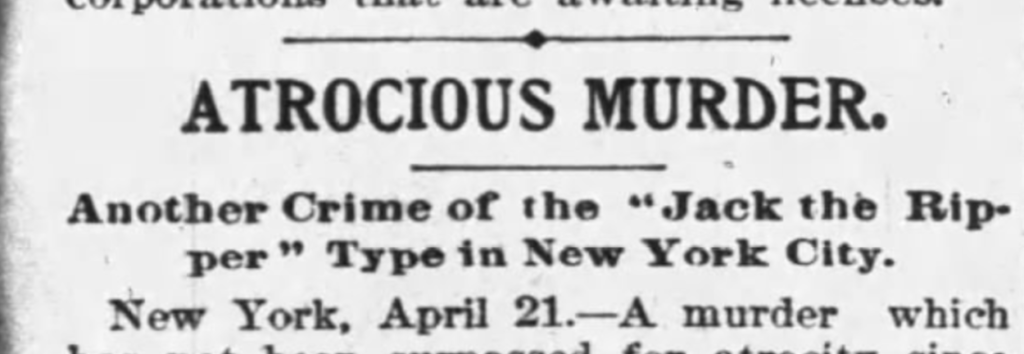
Jack the Ripper’s alleged ‘New York City spree’ is the sinister pretext for the murder investigation depicted on The Alienist. Investigators in 1896, just five years after the death of Carrie Brown, would have had knowledge of Jack’s possible appearance on the streets of New York.
Of course, nothing has ever been proven that Brown’s death was associated in any way with the 1888 murders in Whitechapel. But that didn’t stop the press from speculating. After all, such twisted, grotesque crime sold newspapers.
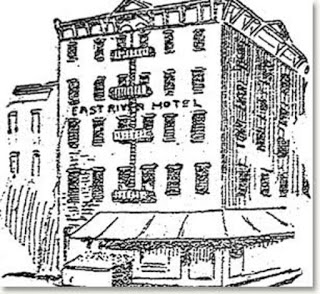
The circumstances of Brown’s ghastly murder were indeed extraordinary.
Let’s quote from that defining text of New York City crime folklore — Gangs of New York by Herbert Asbury. “The first Jack-the-Ripper murder in New York is said to have occurred [at the old East River Hotel at Catherine and Water streets] when an old hag known as Shakespeare was cut to pieces.”

Brown was known as Shakespeare for her habit of quoting the bard whenever possible. According to Asbury, “Shakespeare always claimed that she had come from an aristocratic family and that in her youth she had been a celebrated actress in England. She supported her contention by reciting, in return for a bottle of swan gin, every female role in Hamlet, Macbeth and The Merchant of Venice.”
Her lifeless body was discovered the next morning, stabbed and repeatedly slashed with a cross cut into her thigh.
Below: Brown’s body wore mutilations similar to those found in the Whitechapel killings
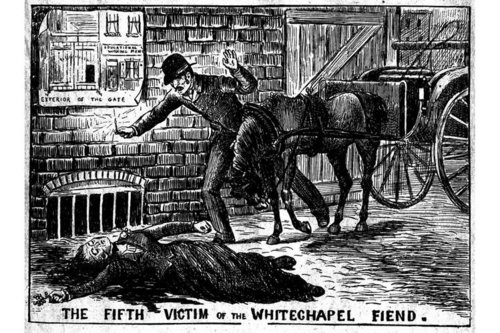
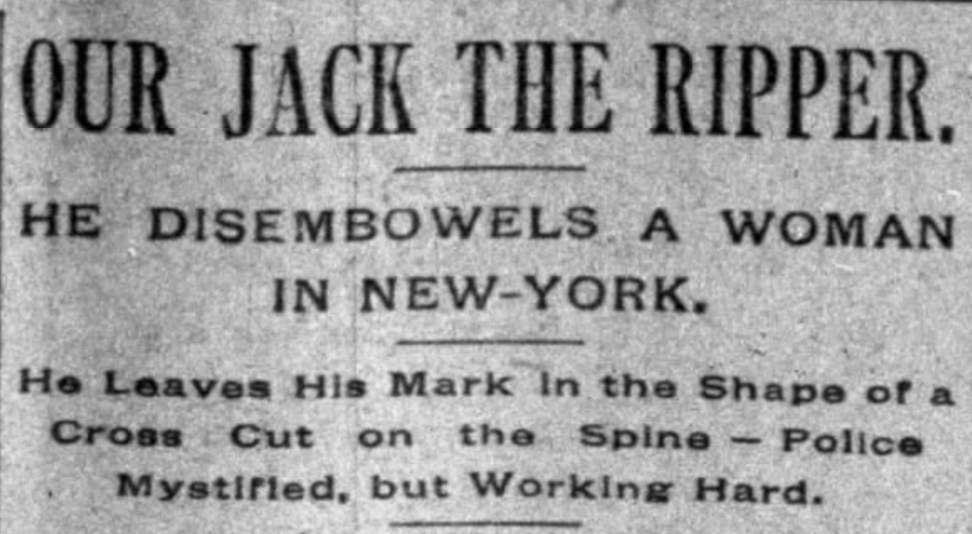
From the Evening World the day following her murder: “No crime which has been committed in this city for years has stirred the Police Department to such tremendous activity as the horrible butchery of Carrie Brown, alias ‘Old Shakespeare’ by ‘Jack the Ripper or his double, at the East River Hotel.”
Police chief inspector Thomas F. Byrnes had previously chided Scotland Yard for their inability to catch a killer. Perhaps that’s why there was an immediate arrest in the case — an Algerian man named Ameer Ben Ali (nicknamed Frenchy). He was convicted of the crime and unjustly sent to prison, despite little evidence of his involvement in the murder. (He remained there for eleven years before he was eventually exonerated.)
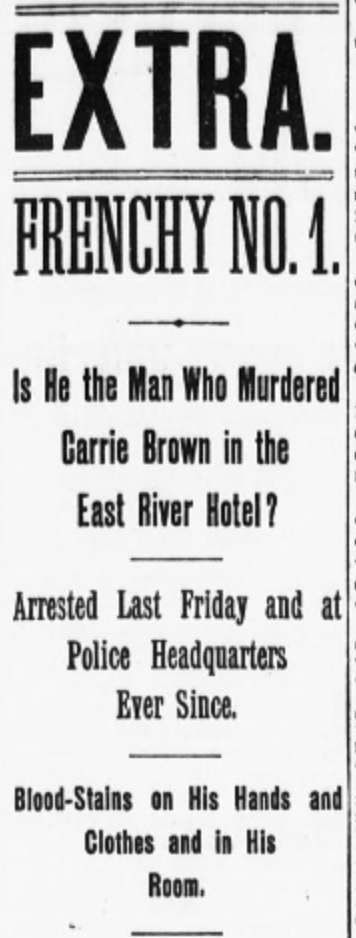
There were doubts about Ameer Ben Ali’s involvement with the murder from the very beginning — as evidenced by this poem in the Buffalo Morning Express, published a couple of weeks after the murder.
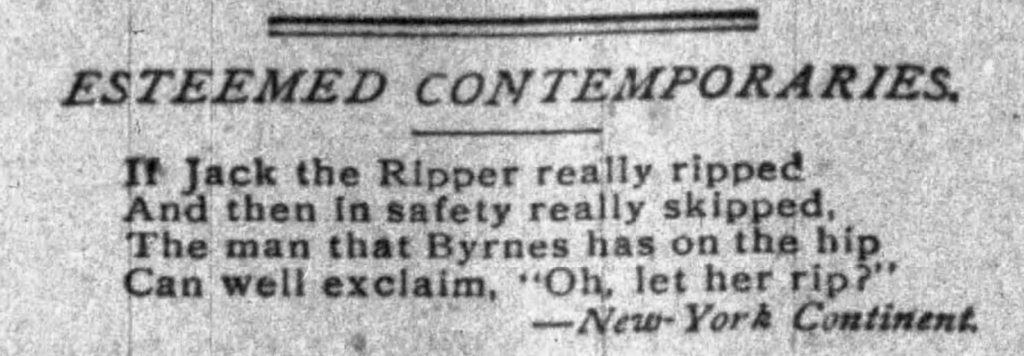
It didn’t matter that, in 1891, Jack seemed to have resumed his murder spree at the very same time in London. It’s unclear whether the London slayings attributed to this singular killer were related to the 1888 murders but newspapers made the assumption anyway. In total, eleven ‘Whitechapel murders’ from 1888 to 1891 are attributed to Jack.
Below: Puck Magazine, published at the Puck Building on Houston Street, speculated on the Ripper’s identity in 1889.
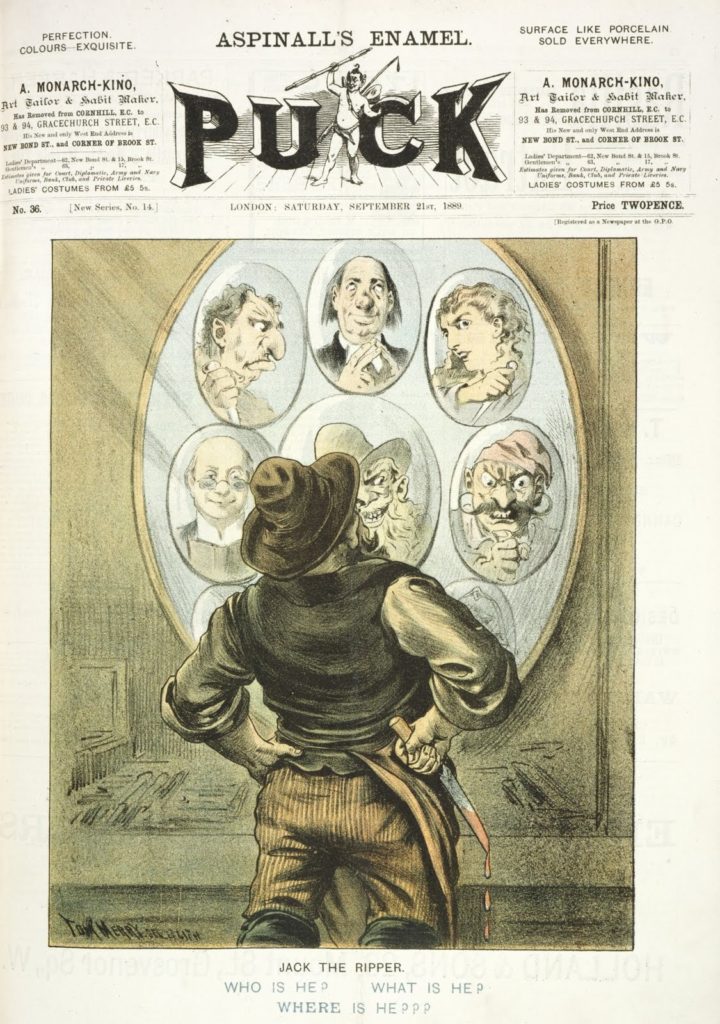
Brown’s murder was not the only one eager newspaper publishers linked to the legend of Jack the Ripper. It happened with such frequency that Twentieth Century Magazine (published in May 1891) attempted to explain the phenomenon. “A little more than a month ago a homicide was committed in New York, the incidents of which were so like those attending the London homicides that the unknown perpetrator of the deed was also called Jack the Ripper. So that the name of Jack the Ripper stands for a person who kills a woman or women and afterword mutilates the body or bodies.”
Jack the Ripper was reportedly seen throughout New York, due to the many eyewitness descriptions of both the London killer which ran in American newspapers and descriptions of the suspected New York killer.
Below: Such headlines ran in the newspapers even before the Carrie Brown murder (New York World, March 8, 1891)

Below: From the Buffalo Evening News (May 25, 1891)
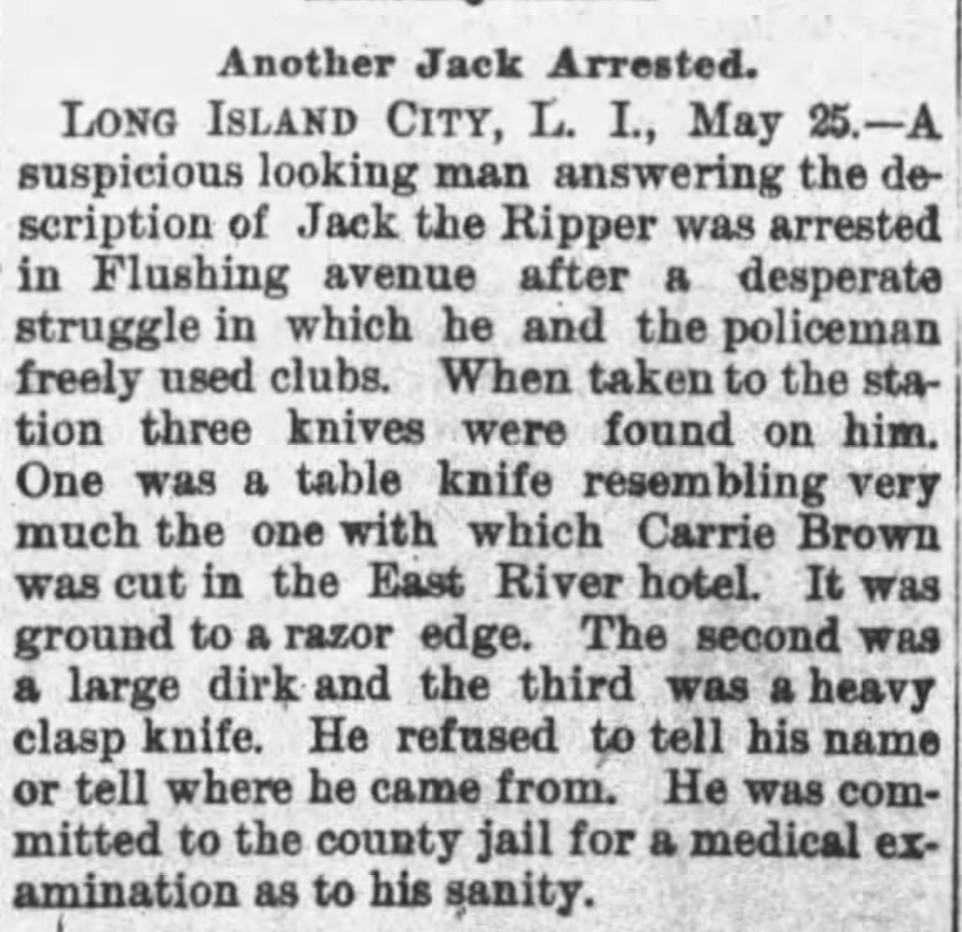
Publishers’ verve in linking any and all grisly murders to London’s killer might have inspired the following letter, sent to the New York Evening World offices on December 17, 1892:
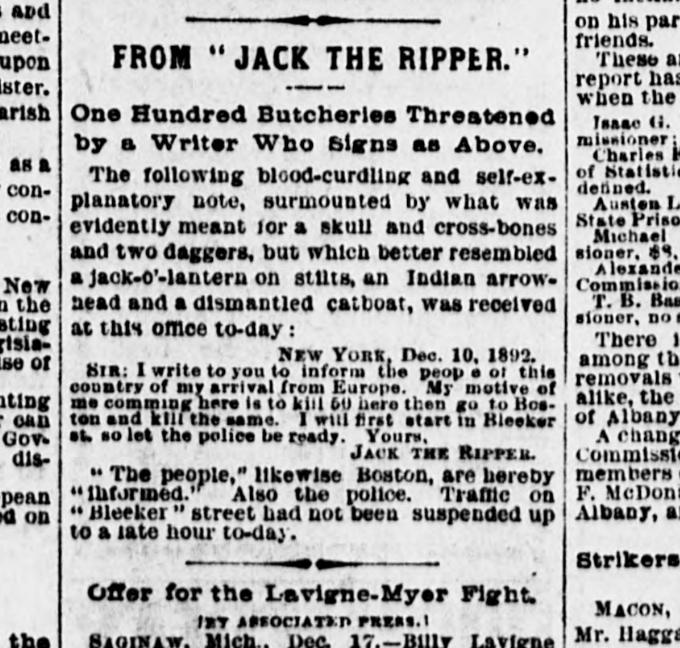
(For those following The Alienist, Bleecker Street is also the destination of choice for that story’s killer.)
In the late fall of 1893, the body of a mutilated woman was found in the East River, and it too, for a time, was linked to Jack the Ripper. “On the hasty examination made last night some marks, taken to be somewhat similar, were discovered, but a thorough examination made this morning shows that they were simply bruises.”
By 1894 people stopped looking for Jack the Ripper in New York although several arrested murderers were described very explicitly as Ripper-style killers. One example from February 3, 1894: “Only a little over two years ago Henry G. Dowd rivaled the fiendish Jack the Ripper by slashing seven intoxicated, but inoffensive men in the Fourth Ward.”

10 replies on “The Alleged New York Murders of Jack the Ripper”
Please please look at ebay the Pankhurstt Family Hairloom the jack the Ripper is leo baekeland!!!! I have the photo made by him!!!!!!!!
Yes, I have found the photo you speak of.
I speculate that my great-uncle Percy Richard Williams (1858-1927) could have been the killer. He disappeared from London in the late 1880s, and reappeared in New York City in 1889, where he assumed a new identity of “Ernest Percy de Neuville” and married (probably bigamously) in Manhattan. He had two children with his new wife before returning with her to his native London and producing five more. He never revealed his previous identity, even to his children, whose descendants now live in England, Ohio USA and Australia.
The identity of the killer is known and it isn’t Percy Williams.
It is the man identified by the name ‘C. Kniclo’, who went to Room 31 with Carrie Brown.
We know it was him because ‘C. Kniclo’ ( this fictitious name was written down after the discovery of Brown’s corpse by a true life killer named Tommy Thompson, an employee of the East River Hotel) took the key to the hotel room with him back to Cranford, N.J. where he was working for a man named George Damon. Damon did not come forward until late 1901 or early 1902, only then going to the authorities who in turn got the machinery of a pardon for Ameer Ben Ali in motion…and it succeeded in his release by NY Gov. Benjamin Odell in April of 1902. “C. Kniclo’ was a man described by Damon as a ‘Danish Farmhand’ who he picked up in south Manhattan and hired him as a laborer. On April 23rd, ‘C.Kniclo” picked Brown up; went to the hotel; and murdered her late on April 23rd or early April 24th. Amazingly, two people who could have helped create reasonable doubt at his trial were not subpoeaned, although one went from his ship to see one of Ali’s defense team in Manhattan and the other, a nightman at the Glenmore Hotel in Chatham Square. The latter’s confrontation with a blood stained man shortly after the murder and deposition he provided the press and possibly the police matched Mary Miniter’s eyewitness testimony ( the basis of the blonde man sketch) to the letter.
We know who the murderer of Carrie Brown, where he had worked prior to the murder…..bad not his name. We’re still working on it.
Howard Brown, JTRForums.Com
Curious if this person could be Jack the Ripper and related? Or just a unequal piece of the puzzle
If he never revealed his identity to anyone, how do you know it?
It was important to note that at the crime scenes in Sept and November of 1888 “Jack” sliced to the right, laid the victims entrails, breast, and various parts of the anatomy to the right. Someway he connected a personal attachment, feeling, euphoric to ‘love in on the left brain and heart to coming away or leaving ‘love’ out the right side of the body. He in fact had a sexual deformity that only could give him some satisfaction with his hands.
He may have been a hermaphrodite skilled with the use of surgical tools
to live out a wish to change his sexual organs. To wanted to alter his appearance inside and out. Unfortunately science was not able to perform these transformation to any degree of success. That frustration irrupted into facial mutilation to hide his real appearance in the faces of women.
It was extremely important that the crime scene had a methodical lay out and placement of the body and parts.
Especially to the near severing of the head. His where about after the crimes is as obscure as before the crimes. That to I believe is a theory I’m developing in an upcoming series of short stories.
I have enjoyed reading these possible theories. Please continue to leave comments, thenovelist
What do you guys think of the possibility of the HH Holmes connection to this that the fact that he was a doctor that he did murder people and of his murders its been said he sold body to some people who bought bodies then said skin cut off in the same way jack last victom in London was cut down the body. From him down to the possibility that he was in London during the time period and his many known aliases could be him as well as London’s own belief in it could have been possibly American doctor will. To top it off records show him in New during this murder as well as smillar in Chicago during world’s fair.
I know this is just a silly thing that I’m going to add at the bottom but I have interest in Jack the Ripper and the HH Holmes possibilities cuz I played as a female ripper in haunted houses for many years and have learned quite a bit about the history trying to capture the character for live acting to scare people in the haunts
Check this out an piece of an article about it
(READ MORE: H.H. Holmes: The Victims of Chicago’s First Serial Murderer
Mudgett is not the first to claim to know the identity of Jack the Ripper and he will not be the last. Although Mudgett’s theory is controversial, it is hard to deny the eerily similar overlap between Holmes’s and Jack the Ripper’s psychopathic, brutal, and grotesque murderous histories. The details of their sadistic killings culminate into nothing short of Hollywood horror. In fact, their stories have been solidified in films for nearly 100 years. Jack the Ripper’s horrific crusade can be seen in films from Waxwork (1924) to Ripper (2016). Holmes’ violent murders are detailed in H.H. Holmes: America’s First Serial Killer (2004) and Havenhurst (2017) as well as in the upcoming film, Devil in the White City, based on the book by Erik Larson, starring Leonardo DiCaprio as Holmes and directed by Martin Scorsese. )
Leo baekeland held a detective issue portable camera and photographs 5x his victims to negatives he would then smuggle to New York. He would later superimpose all 5 victims to one photo as his trophy on his “velox” invented photographic paper. There is also a little boy in the picture and a geological signature of a waterway that’s identical to king’s bridge, he’s also the 1896 killer the alienist using the croton aqueduct on his property to access commit murders in secret he is the only one statistically capable to make the photo, avoid detection as a wealthy figure of the time and part of the naval committee. He killed an identical woman at East River hotel because he hated the name East – for George Eastman Kodak who ruened his invention 1887 with a superior printing process/plates. The photo is in Australia how it got here and all the answers are to much to fit on here I will say I have supporting evidence like watermarked letters “Basildon bond” (London paper). Certification from the states top archeologist/authenticator for the state library and museum and for whos seen the story and evidence in person – know the biggest story is coming soon to the world.
Any questions veloxphoto@gmail.com